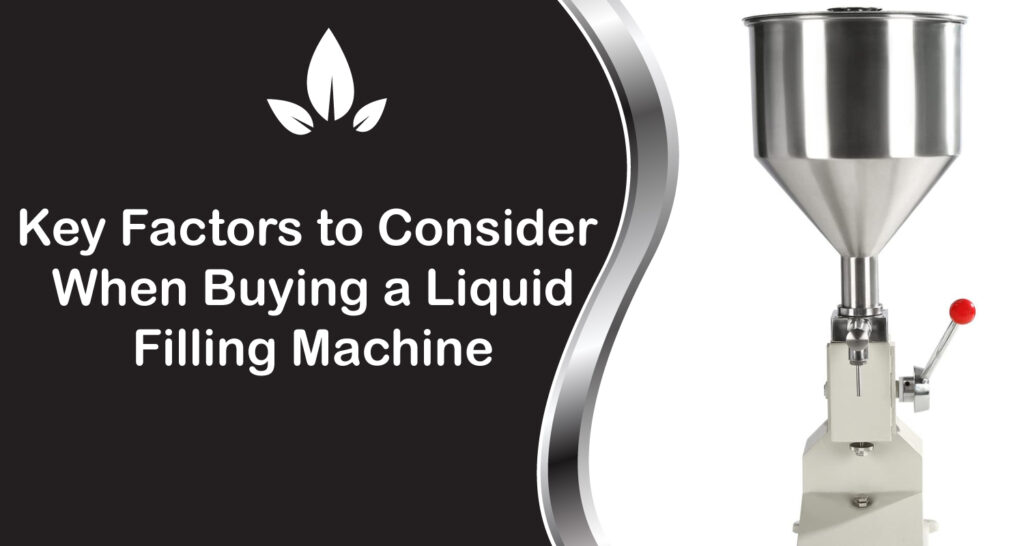In modern manufacturing, precision, consistency, and efficiency are critical to maintaining product quality and meeting customer demand. Whether you’re producing bottled water, sauces, essential oils, detergents, or pharmaceuticals, your filling process is one of the most important stages in your production line.
Choosing the right liquid filling machine isn’t just a purchasing decision—it’s a strategic investment that affects productivity, cost-efficiency, and long-term scalability. With countless types and models on the market, knowing what to look for can make the difference between a smooth, profitable operation and one plagued by downtime or product waste.
In this guide, we’ll explore the key factors to consider when buying a liquid filling machine, from technical requirements and product characteristics to budget and after-sales support.
1. Understand Your Product First
Before choosing any machine, you must understand the physical and chemical characteristics of your product. The type of liquid you’re filling determines the type of machine and filling principle you need.
A. Product Viscosity
Viscosity refers to how thick or thin a liquid is. This property determines how the liquid flows through nozzles and valves.
- Low-viscosity liquids: Water, alcohol, juice → Gravity or overflow filling machines
- Medium-viscosity liquids: Oils, liquid soaps, syrups → Pump or pressure fillers
- High-viscosity liquids: Honey, sauces, creams → Piston fillers or servo-controlled fillers
Choosing a machine that matches your product’s viscosity ensures accuracy, prevents leaks, and maintains consistent fill levels.
B. Foaming and Carbonation
Liquids that foam easily (such as detergents or beer) require special handling. Overflow filling machines are ideal for foamy liquids since they maintain even fill levels without trapping air bubbles.
Carbonated beverages need pressurized systems that can handle gas without causing product loss.
C. Chemical Composition
If your product is corrosive, acidic, or volatile, the machine’s contact parts should be made from corrosion-resistant materials such as 316L stainless steel or PTFE.
D. Temperature and Filling Conditions
Some liquids are filled hot (like sauces or oils), while others must remain cold (like milk or beer). Always check the machine’s temperature tolerance to ensure it can safely handle your product.
2. Identify the Right Filling Method
Different machines use different principles to measure and dispense liquid. Understanding these will help you choose one that delivers the precision and efficiency you need.
Filling Type Working Principle Best For Gravity Filler Uses gravity to fill free-flowing liquids Water, juice, wine Pressure Filler Uses pressure to push thick liquids Oils, detergents Overflow Filler Fills to a consistent level (excess returns to tank) Foamy or transparent liquids Piston Filler Measures by piston volume Honey, sauce, paste Pump Filler Uses gear, peristaltic, or lobe pumps Cosmetics, chemicals Vacuum Filler Fills by suction under vacuum Perfumes, essential oils Weight (Gravimetric) Filler Fills by product weight Expensive or density-variable products
Each method offers different advantages depending on viscosity, accuracy requirements, and cost.
3. Determine Your Required Production Capacity
Production capacity is one of the most important considerations.
Ask yourself:
- How many bottles do you need to fill per hour or per shift?
- Are you operating single or multiple product lines?
- Do you expect to scale up production soon?
A. Small Production (Up to 1,000 bottles/hour)
- Best Option: Semi-automatic piston or gravity filler
- Why: Lower cost, flexible, easy to operate
B. Medium to Large Production (1,000–10,000 bottles/hour)
- Best Option: Fully automatic filling line
- Why: Continuous operation, reduced labor, consistent output
C. Industrial High-Speed Production (10,000+ bottles/hour)
- Best Option: Rotary automatic filler with integrated capping and labeling
- Why: High precision, maximum speed, and full automation
Choosing the right capacity ensures your investment matches your production demand without overpaying for unused capability.
4. Select the Right Level of Automation
Automation has a major impact on efficiency, cost, and workforce requirements.
Automation Level Description Best For Manual Operator fills and caps containers by hand Small startups or lab use Semi-Automatic Machine fills automatically, operator loads and unloads containers Small and medium production Fully Automatic Conveyor-driven system handles filling, capping, labeling Large-scale production lines
Semi-automatic machines offer flexibility and low initial cost but require more labor. Fully automatic systems, though more expensive, drastically reduce human error and labor costs while increasing output.
For businesses planning to scale up, choosing a machine that can later be upgraded to a fully automated line is the most cost-effective strategy.
5. Choose the Right Construction Material
The filling machine’s material must meet both durability and food safety requirements.
- 304 Stainless Steel: Standard for most food and beverage applications.
- 316L Stainless Steel: Used for acidic or corrosive products such as fruit juices, beer, and cleaning chemicals.
- PTFE / Silicone: Used for seals and gaskets where chemical resistance is needed.
Always ensure that contact surfaces are food-grade, non-reactive, and easy to clean. Stainless steel is the best option because it resists corrosion, prevents contamination, and ensures long-term reliability.
6. Focus on Accuracy and Consistency
Filling accuracy directly affects profitability. Overfilling wastes product, while underfilling can violate packaging regulations and damage customer trust.
Accuracy depends on:
- Machine design (volumetric or gravimetric)
- Quality of sensors and valves
- Pressure stability
- Product viscosity and temperature
Piston and gravimetric fillers are typically the most accurate for high-value or regulated products. Investing in a precise filling system will quickly pay off through reduced waste and improved quality control.
7. Consider Cleaning and Maintenance Requirements
Hygiene and maintenance are crucial, especially in the food, beverage, and pharmaceutical industries. Look for machines that are:
- Easy to disassemble for cleaning
- Compatible with CIP (Clean-In-Place) systems
- Built with smooth welds and sanitary fittings
- Designed to prevent product residue buildup
A machine that’s difficult to clean can lead to contamination, downtime, and costly product recalls. Stainless steel equipment is ideal for maintaining strict sanitation standards.
8. Check Compatibility with Container Types
Your filling machine must handle the shapes, sizes, and materials of your containers.
Ask:
- Are you filling glass, PET, or aluminum bottles?
- Do you use narrow-neck or wide-mouth containers?
- Will you need to fill multiple sizes or formats?
Machines with adjustable nozzles and height settings allow quick changeovers between container types, saving time and increasing flexibility.
9. Evaluate Integration with Other Equipment
Modern factories rarely operate standalone filling machines. Most production lines integrate:
- Cappers and sealers
- Labelers
- Conveyors and bottle feeders
- Inspection systems
Ensure your filling machine can integrate smoothly with existing or future equipment. Micet, for instance, offers fully integrated filling and packaging solutions with synchronized PLC controls for seamless line operation.
10. Verify Compliance with Industry Standards
To ensure food safety and regulatory compliance, your filling machine should meet international standards such as:
- GMP (Good Manufacturing Practices)
- CE Certification
- FDA Food Contact Requirements
- 3-A Sanitary Standards (for dairy and beverage equipment)
- ISO 9001 Quality Management Systems
Certification ensures the machine is built with safe materials and proper design for hygienic operation.
11. Factor in After-Sales Support and Spare Parts Availability
Even the best machines require regular servicing and occasional replacement parts. Before buying, confirm that your supplier offers:
- Local technical support or remote assistance
- Quick spare part availability
- Operator training and installation help
- Preventive maintenance programs
Reliable after-sales service reduces downtime and ensures consistent productivity throughout your equipment’s lifespan.
12. Don’t Forget Scalability and Future Expansion
Your production needs today may not be the same tomorrow. A good filling machine should allow for future upgrades, such as:
- Adding more nozzles
- Integrating conveyors or cappers
- Upgrading from semi-automatic to full automation
Modular, scalable designs help you expand production capacity without replacing your entire system.
13. Budget and Total Cost of Ownership
When budgeting, don’t focus solely on the purchase price. Consider the total cost of ownership (TCO), including:
- Energy consumption
- Labor savings
- Maintenance and spare parts
- Downtime costs
- Expected machine lifespan
Sometimes, a higher upfront investment in a high-quality automatic filling system leads to significant long-term savings.
14. Why Choose Micet’s Liquid Filling Equipment
When it comes to selecting reliable and efficient filling systems, Micet is a trusted manufacturer serving the food, beverage, chemical, and pharmaceutical industries worldwide.
Why Micet Stands Out
- Premium Construction: All product-contact parts are made from 304 or 316L stainless steel, ensuring durability and hygiene.
- Wide Range of Options: From semi-automatic units for startups to fully automatic filling lines for industrial-scale production.
- Precision Control: PLC automation, touchscreen operation, and servo motors for consistent accuracy.
- Customization: Tailored filling solutions based on viscosity, bottle size, and production capacity.
- Seamless Integration: Compatible with labeling, capping, and packaging systems.
- Global Support: Installation, operator training, and after-sales service to ensure long-term reliability.
Whether you’re bottling water, sauces, oils, or cleaning solutions, Micet’s filling equipment guarantees precision, efficiency, and compliance with international food safety standards.
👉 Explore Micet’s full range of liquid filling systems at MicetCraft.com and find the right equipment for your production line.
FAQs
1. How do I choose between a piston, gravity, and overflow filling machine?
It depends on your product:
- Piston filler: Best for thick liquids like honey or sauces.
- Gravity filler: Best for thin, free-flowing liquids like juice or water.
- Overflow filler: Best for clear or foamy liquids like shampoo or detergent.
Your product’s viscosity and visual requirements will determine the right system.
2. Can I use one filling machine for multiple products?
Yes, but it depends on machine design. If your liquids have similar viscosity, you can use the same machine with quick adjustments. However, for drastically different products (like oil and sanitizer), it’s better to have dedicated machines or separate contact parts to avoid cross-contamination.
3. What maintenance does a liquid filling machine require?
Routine maintenance includes cleaning the contact parts, checking seals and nozzles, lubricating moving components, and recalibrating sensors. Regular servicing prevents leaks, ensures accuracy, and extends equipment life.


